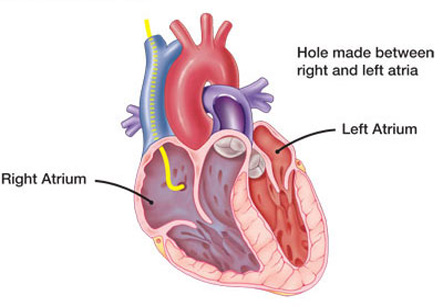Atrial Septostomy
Introduction
Atrial septostomy is a procedure in which a small hole is created in the wall between the left and right atria of the heart. The hole can be made using the technique of cardiac catheterization (insertion of a thin flexible tube into the chambers or blood vessels of the heart from arm or groin vein).
Atrial septostomy can reduce the pressure in the right side of the heart which allows the heart to pump more efficiently. This improves blood flow to the lungs.
Some people with pulmonary hypertension (increased blood pressure in lung vessels) faint occasionally when there is a sudden increase in back pressure in the lungs. Making a small hole in the septum (wall) between the right and left atria (atrial septostomy) can help to reduce fainting. The hole acts as a safety valve for the purpose of decompression of the right heart when the pressure increases suddenly. This reduces the chances of fainting.
Atrial septostomy is useful in people with advanced PH as it reduces pressure in the right side of the heart.
Iran is among the top 10 countries in treating cardiovascular diseases, while it ranks first in the Middle East

Atrial septostomy (AS) is a procedure performed in children with a variety of congenital cardiac diseases to create an iatrogenic intracardiac shunt. In severe PAH this procedure creates a right-toleft shunt which results in improvement of haemodynamic parameters and augmentation of systemic blood flow. The right ventricular hemodynamic are also improved, particularly during exercise. According to studies, the patients with Eisenmenger’s syndrome (an anatomical right-to-left shunt) have better survival even with the same degree of pulmonary hypertension than those with primary pulmonary hypertension.
Indications
In a normal heart, oxygen-depleted blood is pumped from the right side of the heart through the pulmonary artery, to the lungs for oxygenation. This is called as pulmonary circulation. The oxygen-rich blood then returns to the left heart via the pulmonary veins. This blood is then pumped through the aorta to the rest of the body, including the heart muscle itself. This is called as systemic circulation. These two loops are interconnected to form normal cardio-pulmonary system.
In a disease known as transposition of great vessels (TGA), certain major blood vessels are connected in improperly. The deoxygenated blood from the right heart is pumped immediately through the aorta and circulated to the body and the heart itself. In this condition, the lungs are bypassed altogether and the left heart pumps oxygen-rich blood continuously back into the lungs through the pulmonary artery. This is a life-threatening condition as the resultant low oxygen levels are circulated throughout the body. Atrial septostomy can be helpful in this situation as it allows more of the oxygen-rich blood to circulate in the body. This procedure is a temporary measure for survival of the patient until further corrective surgery is performed.
In the cases of isolated pulmonary hypertension, abnormally high blood pressure in the blood vessels within the lungs puts stress on the right side of the heart and this may lead to right heart failure. Atrial septostomy relieves some of this pressure, but at the cost of lower oxygen levels in the blood. In this case also, the atrial septostomy is not a definitive solution to the underlying medical problem.
Procedure
Balloon atrial septostomy:
The majority of atrial septostomies are performed in infants with TGA or other cyanotic heart defects. In this procedure, a balloon catheter is guided through a large vein into the right atrium during cardiac catheterization. The catheter is threaded into the foramen ovale(a naturally-existing hole between the atria that normally closes shortly after birth). After this, the balloon at the end of the catheter is inflated so as to enlarge the foramen ovale. The balloon is inflated till the foramen ovale is large enough to not to get sealed again. This allows more oxygenated blood to enter the right heart which can be pumped to the rest of the body. The balloon is deflated and the catheter is removed. When done in children, this surgery requires general anesthesia.
Blade atrial septostomy:
Sometimes the initial surgery is not entirely successful or some other factors make a simple balloon atrial septostomy impossible. This can happen in an older patient whose foramen ovale has already closed. In this case, a blade atrial septostomy needs to be performed. The procedure is almost similar to balloon septostomy, except that a small blade present on the end of the catheter is first used to create an opening between the right and left atria before the insertion of the balloon.